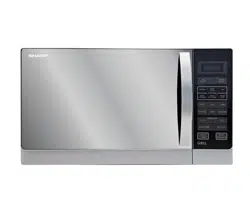Loading ...
Loading ...
Loading ...

GB-19
WARNING: Never adjust, repair or modify the
oven yourself. It is hazardous for anyone other
than a SHARP trained engineer to carry out
servicing or repairs. This is important as it may
involve the removal of covers that provide
protection against microwave energy.
• The door seal stops microwave leakage during oven
operation, but does not form an airtight seal. It is
normal to see drops of water, light or feel warm air
around the oven door. Food with a high moisture
content will release steam and cause condensation
inside the door which may drip from the oven.
• Repairs and Modifications: Do not attempt to
operate the oven if it is not working properly.
• Outer Cabinet & Lamp Access: Never remove the
outer cabinet. This is very dangerous due to high
voltage parts inside which must never be touched,
as this could be fatal.
Your oven is not fitted with a lamp access cover. If
the lamp fails, do not attempt to replace the lamp
yourself, call a SHARP approved service facility.
Keep the power supply cord away from heated
surface. If you think the oven is not working properly
there are some simple checks you can carry out
yourself before calling an engineer. This will help
prevent unnecessary service calls if the fault is
something simple.
Follow this simple check below: Place half a cup of
water on the turntable and close the door. Programme
the oven to cook for I minute using 100% microwave
power.
1. Does the oven lamp come on when it is cooking?
2. Does the turntable rotate?
3. Does the cooling fan work? (Check by placing your
hand above the air vent openings.)
4. After I minute does the audible signal sound?
5. Is the water in the cup hot?
6. After 3 minutes, does the grill heating element
become red?
If you answer "NO" to any question first check that
the oven is plugged in properly and the fuse has not
blown. If there is no fault with either, check against
the troubleshooting chart below.
TROUBLESHOOTING
TROUBLESHOOTING CHART
QUERY ANSWER
Draught circulates
around the door.
When the oven is working, air circulates within the cavity.
The door does not form an airtight seal so air may escape from the door.
Condensation forms
in the oven, and may
drip from the door.
The oven cavity will normally be colder than the food being cooked, and so steam
produced when cooking will condense on the colder surface. The amount of steam
produced depends on the water content of the food being cooked. Some foods, such
as potatoes have a high moisture content. Condensation trapped in the door glass
should clear after a few hours.
Flashing or arcing
from within the
cavity when cooking.
Arcing will occur when a metallic object comes into close proximity to the oven cavity
during cooking. This may possibly roughen the surface of the cavity, but would not
otherwise damage the oven.
Arcing potatoes. Ensure all "eyes" are removed from the potatoes and that they have been pierced, place
directly onto the turntable or in a heat resistant an dish or similar.
The display is lit but
the control panel
will not work when
pressed.
Check the door is closed properly.
Oven cooks too
slowly.
Ensure correct power level has been selected.
Oven makes a noise. The microwave energy pulses ON and OFF during cooking/defrosting.
Outer cabinet is hot. The cabinet may become warm to the touch - keep children away.
Loading ...
Loading ...
Loading ...
